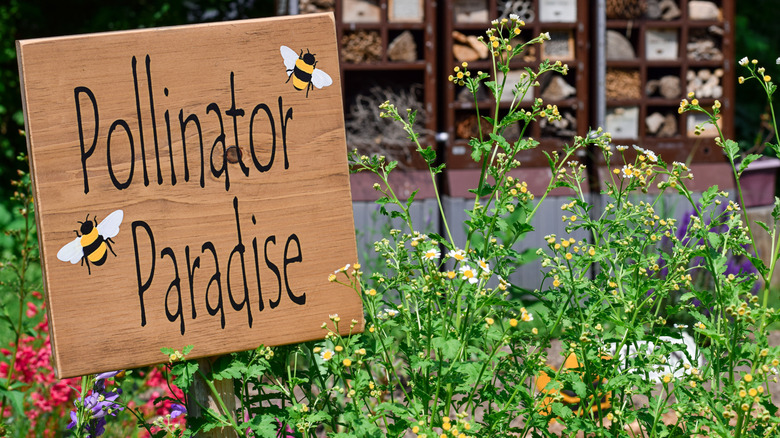Reuse These 8 Common Household Items To Make Your Garden A Pollinator Haven
We may receive a commission on purchases made from links.
Whether you're getting into native plant gardening, joining the anti-lawn movement, or just want to add some amazingly gorgeous flowers and shrubs to your garden, being pollinator-friendly is an excellent goal for your garden. But, let's face it, making it easier for pollinators to find your yard typically requires a few investments that can add up quickly. While we've already covered some brilliant ways you can use old mason jars to attract more birds, there are other clever hacks that turn household containers into havens for smaller birds, bees, and more. So, we've scoured social media to find some incredible DIY options that take things that you probably already have lying around and can give them a new pro-pollinator purpose.
The best part is that none of these require hardcore power tools or extensive knowledge — just a willingness to make life easier for the birds, bees, butterflies, and other friends. Plus, most of these can work anywhere from small balcony container gardens to expansive outdoor paradises. So, grab the "good" scissors and a glue gun because we're about to drop some serious garden crafting inspo.
Build a bee-themed bug hotel with an old tin can
Instead of tossing empties into the recycle bin, reuse those old soup cans by turning them into bee hotels. Bee hotels are like birdhouses; they're meant to provide a safe and dry nesting spot for bees to chill. This TikTok uses a power drill to make holes to thread a hanging cord through. However, you can skip that if you're drill-less and just wrap a wire around the can a few times for stability. Fill it with twigs and reeds so that bees have safe spots to hide and nest.
Take extra buckets and turn them into a pollinator water station
Pollinators need water, too, and will appreciate a little water station all their own. To make one, stack two buckets, fill the top bucket with water, and insert the pump. You can use a plug-in one or make life easier with a cheap solar pump like Biling's Solar Water Fountain Pump Kit. Then, use a bucket lid or plate that's large enough to rest on the bucket, and run a small tube up so that the water moves from the bottom bucket to where the pollinators can reach.
Or, fill a shallow bowl with rocks to create a pollinator waterer
DIY watering stations for your local bees don't need to be elevated or fancy. As this YouTuber shows, simply filling a shallow bowl with water and pebbles is more than enough for getting pollinators the water they need. If you don't have any shallow bowls or plates with taller rims to spare, use a water saucer from an old plant pot instead. The gravel or pebbles make it easier for smaller insects to land and take a drink; just make sure they're rinsed first so that there isn't any debris floating in the water.
Use an old jar to add a gravity-fed reservoir to your pollinator watering station
Evaporation and happy, hydrated pollinators can mean you'll need to refill your water station often. If you'd prefer to automate things a bit, try filling an old mason jar with water and using it as a reservoir. You'll need a jar with a lid and some way to poke holes through it so that water flows when the station dries out. You can use a drill or just buy some Daisy Flower Cut Mason Jar Lids on Amazon.
Turn a kitchen whisk into a place for bird nesting materials
Grabbing all those materials to make your home is rough when you're a small bird or bug. So, make their lives easier by turning an old whisk into a nesting material hub. You can toss a variety of materials in there, but you might want to consider using hummingbird-friendly stuff, like moss or twigs, since they're the main avian pollinators in the US and are just cool to watch. However, skip the pet fur. It's a nesting material that's dangerous for hummingbirds because of residual anti-flea treatments.
Turn mason jars into a DIY hive
Interested in getting a beehive started for cheap? This TikToker shows how they were able to successfully entice bees into using a large mason jar as a makeshift hive. You'll need to leave the lid off so bees can move in and out freely, but screw on the rim. The rim will give the jar stability if you set it upside down; just make sure the bees can access the opening. Some DIYers will drill large holes into plywood, screwing in multiple jars to make a bigger hive.
Empty spice jars can be awesome hummingbird feeders
Hummingbirds are tiny and rarely need big setups. This TikToker shows how they converted a small spice jar into an easy DIY hummingbird feeder. Not only does the red lid help attract hummingbirds, but the semi-opaque jar makes it easy to monitor nectar levels. Just be sure to clean it thoroughly, and wrap a string around the neck a few times for hanging it. Then, fill it with food like Hummingbird Momma's Organic Nectar, and screw the lid back on.
Plastic deli meat containers can help feed hummingbirds, too
Leftover deli meat containers (the ones with the red lids) also make awesome hummingbird feeders. This one requires a little DIY since you'll need to drill holes into the lid that are big enough for their beaks to get into, but you can use a drill bit, solder iron, or hot needle. Use twine to create a hanger by tying it the way you'd tie a ribbon on a package, then add nectar and hang it up. You don't have to use premade nectar mixes to fill it. Instead, homemade hummingbird nectar is surprisingly easy to make.
